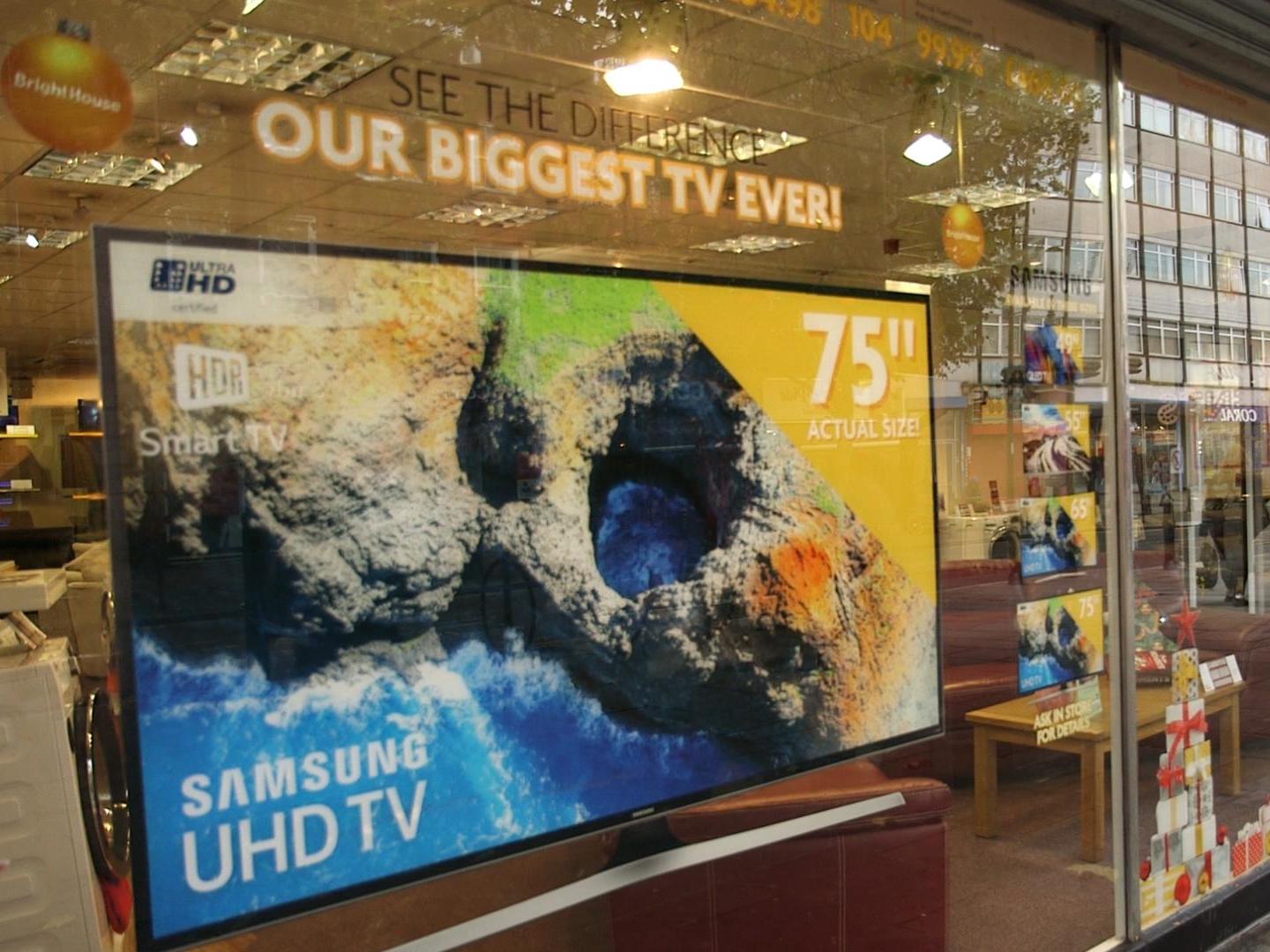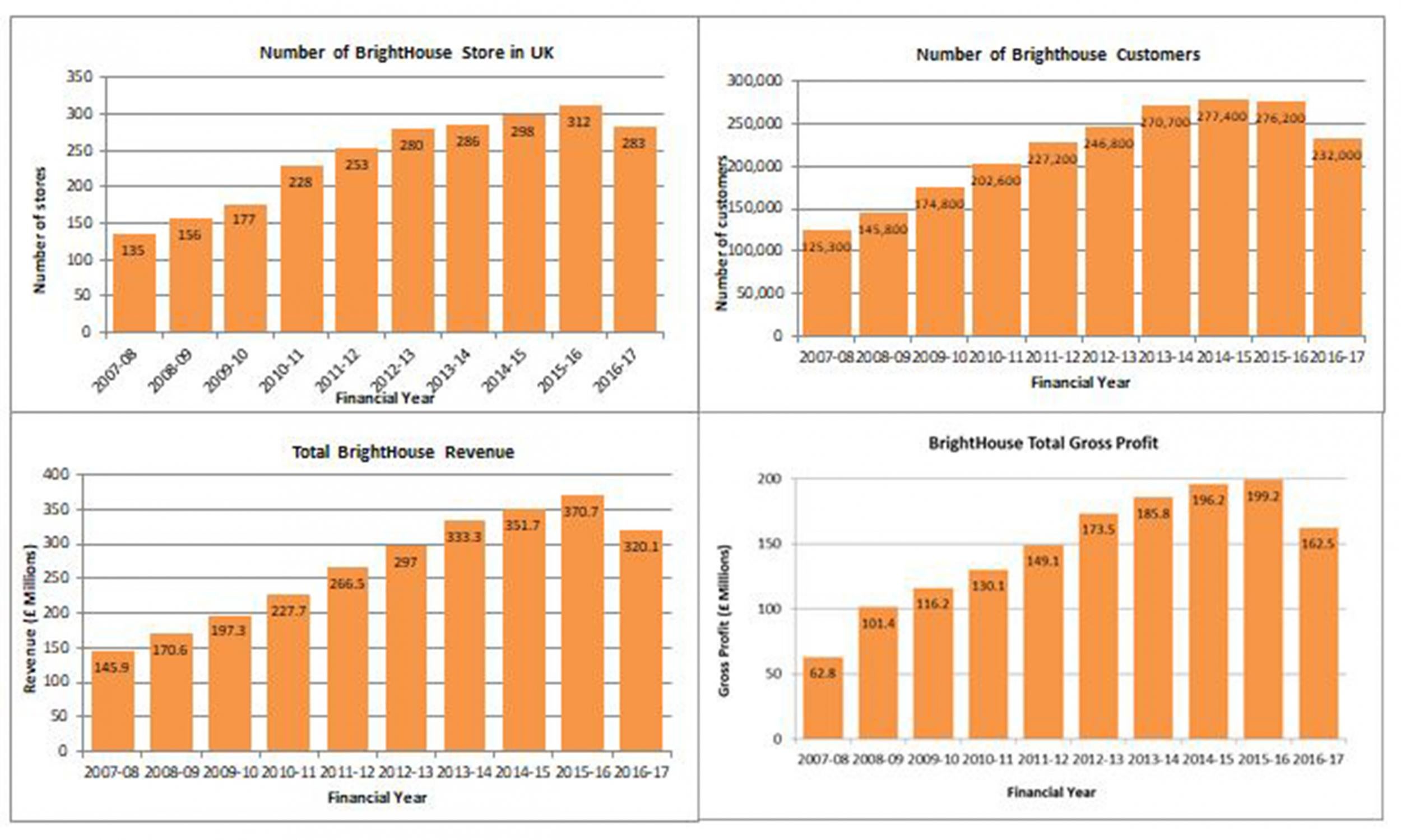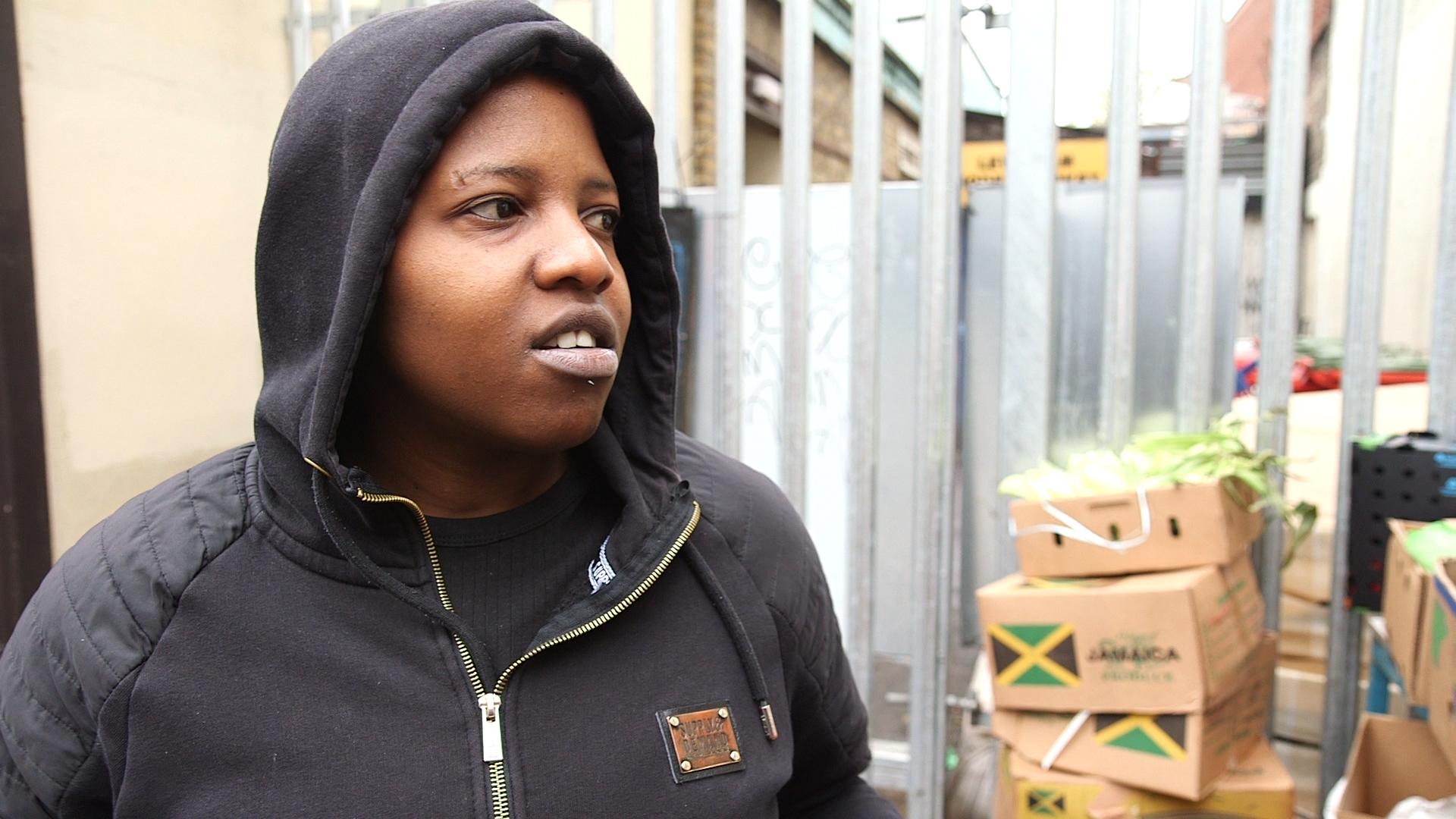Has the Queen's BrightHouse investment helped make Britain's poor even poorer?
As the Paradise Papers leak reveals, some of the Queen’s private wealth is invested in the rent-to-own outlet. But what is BrightHouse and is it exploiting some of Her Majesty’s poorest subjects?
At the “no frills” end of the high street, near where William Hill neighbours Paddy Power, and a few doors away from Poundland, there stands an altogether glossier alternative.
Here, as suggested by the shop’s very name, BrightHouse, all is light and brilliancy.
The lush primary colours of the window ad announce “our biggest TV ever!” beneath depictions of brightly wrapped presents and the promise of “Christmas moments”.
The sales counter is approached via the massed ranks of ultra-high definition widescreen TVs, with the Ecobubble washing machines beyond.
And yet when Nothoizile Kombe exits the store in Lewisham, south-east London, it becomes clear that all is not quite what it seems at BrightHouse – at least not for its customers.
“The rates they charge the poor,” she says, the feisty laughter not quite hiding her frustration, “are extortionate.”
The 25-year-old fast food worker, by her own admission “struggling” on the minimum wage, had asked about a mobile phone.
As she discovered, and as the BrightHouse autumn catalogue confirms, an Apple iPhone 7 Plus would cost her £1,277 with weekly payments of £24.57 spread over a year. Yet Apple is selling the exact same model for £769, or from £886 spread over two years – 30 per cent cheaper than at BrightHouse, with twice the time to repay.

There were plenty of other examples, such as the Samsung 65in ultra HD curved TV that cost £2,914 over two years at BrightHouse, but £1,681 in 24 months at Currys, which was quoting 19.9 per cent APR, a fraction of the 69.9 per cent printed in the BrightHouse brochure.
And that “biggest TV ever”? The 75in Samsung ultra HD smart TV is yours – provided you keep paying £30 a week for three years – for £4,680. Although you could buy it straightaway at Currys for £2,499, roughly half what you would end up paying at BrightHouse.
The idea, of course, is that BrightHouse provides the “rent-to-own” option of small weekly payments for those who can’t afford to buy outright or whose low credit-ratings stop them getting “pay later” deals at other stores.
It’s just that Ms Kombe – and, it has to be said, a fair few others – see it rather differently.
“I get so angry,” she says. “The poor have someone exploiting them over and over and over again – and BrightHouse is part of that.”
And yet, as we now know thanks to the revelations about offshore funds in the leaked “Paradise Papers”, BrightHouse is where the Queen, or perhaps more accurately her financial advisers, ended up investing some of her private wealth.
In 2007 a Cayman Islands-based fund run by an American company asked the Duchy of Lancaster to contribute to five projects including an interest in Vision Capital, which acquired 100 per cent of BrightHouse in June of that year.
The Duchy still has £3,208 invested in BrightHouse.
To some, Ms Kombe included, BrightHouse seems a very odd choice to be the beneficiary of royal investment.
To some, but perhaps not to the Queen or others living at a genteel distance from the breadline, BrightHouse is part of the British “poverty premium”, that curious phenomenon whereby those on the lowest incomes now seem to end up paying more than anyone else. Although those at the top of BrightHouse might possibly prefer to see a success story, created in the “boom” years of what to everyone else was the economic downturn.
According to the Financial Inclusion Centre thinktank, during the austerity years between 2008 and 2016, BrightHouse’s gross profits more than trebled from £62.8m to £192m, as customer numbers more than doubled from 125,300 to 276,200.

In November 2008, as the good times – for BrightHouse – began rolling, a few months after it received the Queen’s money, Leo McKee, the company’s chief executive (who retired in September 2016), gave a revealing interview to the Financial Times.
There were now five million households who were unable to get credit elsewhere and available for him to target, he told the newspaper. While every other retailer was cutting capital expenditure, Mr McKee was planning to expand.
The FT reported at the time that at least 40 per cent of BrightHouse customers were wholly or partially reliant on benefits. The Financial Inclusion Centre would later characterise the typical BrightHouse customer as a single mother on benefits.
But Mr McKee wasn’t going to sell them the cheapest, most basic model on the market.
“Our products have to be aspirational: we can’t sell entry-level products,” he told the FT. “Some retailers can target the first-time buyer or the budget buyer, but we can’t do that because our customers are looking for the telly that gives them bragging rights.
“My head of marketing said to me we shouldn’t advertise in the tabloids. Now that kind of blew my mind, because if you think about the mainstream electrical retailers, they’re all over the tabloids. But he said to me: ‘daytime television’.”
The FT also reported that some 30 per cent of customers were falling behind in the weekly payments and having to return products to BrightHouse, which could then refurbish and resell them as “quality refurbished” or “pre-loved” items.
But Mr McKee rejected accusations of preying on the vulnerable. BrightHouse staff were not on commission, he said. They would try to help customers when they got into financial difficulties.
“Say they’ve got two tellies,” explained the jovial Mr McKee. “The store people will talk to them and say, ‘I think you could do with one.’ They won’t drop to no tellies, though: they’d hand their bed back first.”
BrightHouse APR rates were broadly comparable with other mainstream retailers, said Mr McKee.
But seven years later, in February 2015, MPs on the Debt and Personal Finance All Party Parliamentary Group were reporting that some BrightHouse goods were being sold at 94.7 per cent APR.
“Bascially,” says Gareth Evans, co-author of the Financial Inclusion Centre’s March 2016 report on the sector, “some of rent-to-own was the Wild West during economic downturn, with unchecked practices, ridiculously high growth in customers, in stores, in revenue and gross profit.”
Eventually, from late 2014 onwards, the Financial Conduct Authority (FCA) began “working closely” with BrightHouse. The end result came a month ago, in October 2017.
“Following engagement with the FCA,” the authority announced, “BrightHouse has committed to pay over £14.8m (in the form of cash payments and balance adjustments) to 249,000 customers in respect of 384,000 agreements for lending which may not have been affordable and payments which should have been refunded.”
Jonathan Davidson, executive director of supervision, retail and authorisations at the FCA referred to “historic practices” which meant that: “During the time in question, BrightHouse was not a responsible lender.”
Hamish Paton, Mr McKee’s successor as BrightHouse chief executive, said: “We sincerely apologise to those customers affected. Our top priority is to ensure they are reimbursed. We’re absolutely determined this doesn’t happen again and have made significant improvements over the last 18 months.”
But not everyone seems entirely convinced by the refunds and the promises of “never again”.

Ms Kombe, for example, is rather too scarred by her own experiences and those of her friends.
She tells the story of her friend, a single mother on benefits who last year, while BrightHouse was “working closely” with the FCA, bought a laptop from one of the shops.
“This was the first gadget that she could get to share with her four-year-old daughter, so her little girl could go on YouTube, watch cartoons,” remembers Ms Kombe.
“Most of the other kids had tablets. This girl didn’t have any of that.”
But four months into the £12 weekly payments, her friend got a sanction on her Jobseeker’s Allowance.
“The jobcentre said they sent her a letter about an appointment that she missed, but she never got the letter.
“The sanction meant she didn’t have the £12 a week for BrightHouse. The first week she missed a payment, BrightHouse phoned her.
“The second week the BrightHouse guy is knocking on her door, panicking her. A couple of hours later, she is being told, ‘If you can’t pay, you need to return the laptop.’”
Ms Kombe paid the shortfall out of her own pocket. She didn’t want her friend to lose the laptop with nothing to show for the £190 she had already paid. She also couldn’t bear the thought of BrightHouse taking the laptop from the four-year-old, “like taking candy from a little kid”.
“BrightHouse don’t have customers,” she says. “They poach people.
“It’s like a little system, and it always involves the same people – poor people.”
The incident with the young mother happened, of course, before the FCA announcement and BrightHouse’s “never again” promise.
But Ms Kombe has another story, only a few days old, told to her by a friend who went into another BrightHouse store and was spotted looking at one of the widescreen TVs.
“The guy in the shop said, ‘Listen, I know I work here, but if I were you, I would go somewhere else. It’s extortionate here.’”
The experts too are still sceptical about BrightHouse, despite its engagement with the FCA.
“I remain anxious,” says Yvonne Fovargue, chair of the All Party Parliamentary Group that reported on rent-to-own. “I regard BrightHouse’s business model as one designed to make quite a large amount of profit out of people they deliberately target as being on the lowest incomes and least able to have a wide range of choices.”
So she still worries about BrightHouse shoppers being confronted by all those widescreen TVs and fancy washing machines, and about the apparent signs of continued “upselling” (persuading customers to spend more): “You go in because your washing machine is broken. You just need a machine that washes clothes, but you get sold the latest Ecobubble device.”
BrightHouse, she says, is still putting “amazing mark-ups” on goods that cost much less elsewhere for those able to pay for them straightaway.
“It deliberately puts stores in low-income areas,” she adds. “You don’t see BrightHouse in places like Kensington, do you?
“I just feel they are making a large amount of money out of the people who can least afford it, and that just feels wrong to me. There is enough of a poverty premium already.”
It should be said, however, that the BrightHouse spokesperson was considerably more upbeat.
The Independent was told: “At BrightHouse we allow people with low incomes and poor credit ratings to get access to everyday items they otherwise wouldn’t be able to have.
“Our customers have no long-term commitment, meaning they can return the products at any time without penalty, so you can’t get into a spiral of debt with BrightHouse.
“Over the last 18 months we’ve worked hard to make our business better and more flexible so that we can even better serve our customers who tend to be financially excluded by mainstream lenders.”
And what about BrightHouse’s most illustrious investor, the Queen? A spokesperson for the Duchy of Lancaster said: “The Duchy’s investment in Bright House is through a third party and equates to £3,208 – just 0.0006 per cent of the Duchy’s value.”
Yet on Lewisham High Street, when Hanna, 33, heard of even a fraction of the Queen’s wealth being invested in BrightHouse, her face fell.
“I am so disappointed,” she said.
Now married to a British public-sector worker, with an 18-month-old baby, she had moved to the UK from a Middle Eastern country three years ago.
“I thought it was going to be the best; freedom of speech, a country where people were protected…”
But she had just left BrightHouse – in a hurry: “The prices are crazy,” she said. “They scared me so much I needed to leave the shop.”
This, she said, looking around the high street, was not the Britain she had dreamed of.
“There is austerity, benefits cuts, and the poor aren’t being protected. They are being taken advantage of, exploited.”
Mr Evans and Ms Fovargue speak of solutions. Mr Evans, the MP suggesting more government funding for credit union-style alternatives, is calling for tougher regulation, including safeguards to “prevent households seeing essential goods being taken away even where substantial repayments have been made towards them”.
They mention the more affordable credit union options – like Leeds Credit Union and Fair for You.
But these are not-for-profit groups. As yet, says Mr Evans, they lack the muscle to rival BrightHouse as a presence on the high street: “The trouble is these not-for-profits don’t have the promotional budgets to match those of BrightHouse – people just don’t know about them.”
So for now, in Lewisham, Ms Kombe just shrugs and offers – on the streets of 21st-century London – a sentiment that seems almost reminiscent of Dickensian times:
“They have got their fat bank accounts. They don’t care about people.
“We are the poor folk, and that’s just how it works.”
*Some details have been changed to protect identities
Join our commenting forum
Join thought-provoking conversations, follow other Independent readers and see their replies
Comments